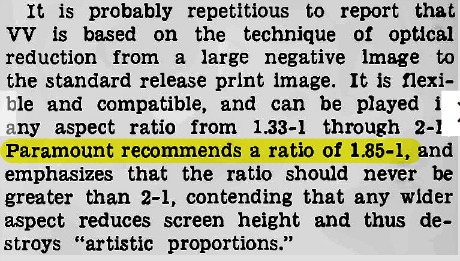Six days ago I reported that the forthcoming Cannes Film Festival screening of a digitally restored version of Marlon Brando‘s One-Eyed Jacks would offer a mixed blessing. While the vivid, wider-than-ever VistaVsion images will surely look beautiful, the aspect ratio presentation will not be within HE’s favored 1.66:1 aspect ratio, nor 1.75:1 or even 1.78:1, but within the dreaded 1.85:1 — a cleavering of the film’s original VistaVision capturings of 1.5:1.

Is this a tragedy? No, but it’s a damn shame — in my view a rash slicing of a significant portion of Charles Lang‘s cinematography, which could have at least been cropped at 1.75:1 or 1.78:1. If you ask me whacking this 1961 Western down to 1.85:1 is damn near unforgivable.
A day after this post appeared on 4.20 HE nemesis Bob Furmanek, who has repeatedly urged DVD/Bluray distributors to crop non-Scope films shot in the mid ’50s to early ’60s at 1.85:1, posted the following in the comment thread: “We were consulted by the Film Foundation and provided documents on this film to insure presentation in the correct aspect ratio”, which Furmanek maintained was 1.85:1 because Paramount recommended this a.r. in a way-back-when message to exhibitors.
This despite the studio having admitted in the same statement [see above] that VistaVision is “flexible and compatible, and [can] be played in any aspect ratio from 1.33:1 to 2.0:1.”
I don’t know where the 1.33 option came from as basic VistaVision photography captures images at 1.5, but Universal and The Film Foundation certainly could have gone with a 1.66, 1.75 or 1.78 aspect ratio.
But no. Furmanek offered research that offered them a rationale for swinging away from these options, and so he was at least partially behind the One-Eyed Jacks cleavering.
This despite the cramped and claustrophobic effect of 1.85:1 cropping having been exposed to one and all by a February 2013 Criterion essay that was included in the On The Waterfront Bluray. This landmark essay also mentions that Paramount’s original VistaVision aspect ratio was 1.66:1. The Criterion essay also states the obvious, which is that the 1.66 a.r. “offers the most natural [looking] compositions.”
Furmanek incrimination #1: A post from American Widescreen Museum’s section on VistaVivision, to wit: “While the first conception of VistaVision called for standard 35mm prints, Paramount felt that the negative quality allowed for a variety of prints to be made. While Paramount tried to keep with their preferred aspect ratio of 1.66:1, they also made provisions for 35mm four perf anamorphic prints with an aspect ratio of approximately 2:1.”
Furmanek incrimination #2: A Film-tech.com post from James Robertson, a Sydney-based film handler, stating that “when I was an apprentice in the 60’s in the heyday of Vistavision all our prints (including 1959’s North by Northwest and The Searchers) were screened 1.66:1 and they looked great in this ratio.”
Furmanek incrimination #3: A post from the Internet Encyclopedia of Cinematographers about VistaVision, to wit: “While Paramount tried to keep with their preferred aspect ratio of 1.66:1,” etc.”
